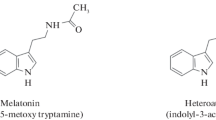Abstract
Melatonin (N-acetyl-5-methoxi-tryptamine), a well-known animal hormone synthetised by the pineal gland, plays a key role in the circadian rhythm of vertebrates. An exhaustive bibliographical revision of studies on melatonin in plants published since 1990 points to very few studies (around 20), of which only 8 have a clear plant physiological focus. The data presented in this study demonstrate that melatonin plays a physiological role in plant tissues. Melatonin is seen to be a molecule that promotes vegetative growth in etiolated Lupinus albus L. hypocotyls, in a similar way to IAA. The measurements of melatonin and IAA in lupin hypocotyls by high-performance liquid chromatography with electrochemical detection, and their identification by tandem mass spectrometry, point to a different distribution of these molecules in etiolated hypocotyls.


Similar content being viewed by others
Abbreviations
- IAA:
-
Indole-3-acetic acid
- MEL:
-
Melatonin
- HPLC–EC:
-
High-performance liquid chromatography with electrochemical detection
- MS/ESI+:
-
Tandem mass spectrometry in positive electrospray ionization mode
References
Beyer CE, Steketee JD, Saphier D (1998) Antioxidant properties of melatonin, an emerging mystery. Biochem Pharmacol 56:1265–1272
Brzezinski A (1997) Melatonin in humans. N Engl J Med 336:186–195
Burkhardt S, Tan DX, Manchester LC, Hardeland R, Reiter RJ (2001) Detection and quantification of the antioxidant melatonin in montmorency and balaton tart cherries (Prunus cerasus). J Agric Food Chem 49:4898–4902
Cano A, Artés F, Arnao MB, Sánchez-Bravo J, Acosta M (1996) Inhibition of etiolated lupin hypocotyl growth and rooting by peroxides, ascorbate and glutathione. J Plant Physiol 147:721–728
Cano A, Alcaraz O, Arnao MB (2003) Free radical-scavenging activity of indolic compounds in aqueous and ethanolic media. Anal Bioanal Chem 376:33–37
Chen G, Huo Y, Tan DX, Liang Z, Zhang W, Zhang Y (2003) Melatonin in chinese medicinal herbs. Life Sci 73:19–26
Chyan YJ, Poeggeler B, Omar RA, Chain DG, Frangione B, Ghiso J, Pappolla MA (1999) Potent neuroprotective properties against the Alzheimer β-amyloid by an endogenous melatonin-related indole structure, indole-3-propionic acid. J Biol Chem 274:21937–21942
Dubbels R, Reiter RJ, Klenke E, Goebel A, Schnakenberg E, Ehlers C, Schiwara HW, Schloot W (1995) Melatonin in edible plants identified by radioimmunoassay and by high performance liquid chromatography–mass spectrometry. J Pineal Res 18:28–31
Foulkes NS, Borjigin J, Snyder SH, Sassone-Corsi P (1997) Rhythmic transcription: the molecular basis of circadian melatonin synthesis. Trends Neurosci 20:487–492
Guerrero JR, García-Ruiz P, Sánchez-Bravo J, Acosta M, Arnao MB (2001) Quantitation of indole-3acetic acid by LC with electrochemical detection in etiolated hypocotyls of Lupinus albus. J Liq Chromatogr Rel Tech 24:3095–3104
Hardeland R, Reiter RJ, Poeggeler B, Tan DX (1993) The significance of the metabolism of the neurohormone melatonin. Neurosci Biobehav Rev 17:347–357
Harumi T, Matsushima S (2000) Separation and assay methods for melatonin and its precursors. J Chromatogr B 747:95–110
Kolar J, Machackova I, Illnerova H, Prinsen E, van Dongen W, van Onckelen HA (1995) Melatonin in higher plant determined by radioimmunoassay and liquid chromatography–mass spectrometry–mass spectrometry. Biol Rhythm Res 26:406–409
Kolar J, Machackova I, Eder J, Prinsen E, van Dongen W, van Onckelen HA, Illnerova H (1997) Melatonin: occurrence and daily rhythm in Chenopodium rubrum. Phytochemistry 44:1407–1413
Ludwig-Müller J, Cohen JD (2002) Identification and quantification of three active auxins in different tissues of Tropaeolum majus. Physiol Plant 115:320–329
Machackova I, Krekule J (2002) Sixty-five years of searching for the signals that trigger flowering. Russ J Plant Physiol 49:451–459
Murch SJ, Saxena PK (2002a) Melatonin: a potential regulator of plant growth and development? In vitro Cell Dev Biol Plant 38:531–536
Murch SJ, Saxena PK (2002b) Mammalian neurohormones: potential significance in reproductive physiology of St John’s wort (Hypericum perforatum L.) Naturwissenschaften 89:555–560
Murch SJ, KrishnaRaj S, Saxena PK (2000) Tryptophan is a precursor for melatonin and serotonin biosynthesis in in vitro regenerated Hypericum perforatum plants. Plant Cell Rep 19:698–704
Reiter R, Tan DX, Burkhardt S, Manchester LC (2001a) Melatonin in plants. Nutr Rev 59:286–290
Reiter R, Tan DX, Manchester LC, Qi W (2001b) Biochemical reactivity of melatonin with reactive oxygen and nitrogen species. Cell Biochem Biophys 34:237–256
Reiter R, Burkhardt S, Cabrera J, Garcia JJ (2002) Beneficial neurobiological effects of melatonin under conditions of increased oxidative stress. Curr Med Chem 2:45–58
Sánchez-Bravo J, Ortuño A, Acosta M, Sabater F (1986) Distribution of indole-3-acetic acid in relation to the growth of etiolated Lupinus albus hypocotyls. Physiol Plant 66:509–514
Sandberg G, Crozier A, Ernstsen A (1987) Indole-3-acetic acid and related compounds. In: Rivier L, Crozier A (eds) Principles and practice of plant hormone analysis, vol 2. Academic Press, New York, pp 169–301
van Tassel DL, Roberts N, Lewy A, O’Neill SD (2001) Melatonin in plant organs. J Pineal Res 31:8–15
Yang S, Zheng X, Xu, Y, Zhou X (2002) Rapid determination of serum melatonin by ESI–MS–MS with direct sample injection. J Pharm Biomed Anal 30:781–790
Yu HS, Reiter RJ (1993) Melatonin: biosynthesis, physiological effects, and clinical applications. CRC Press, Boca Raton
Acknowledgments
This work was supported by the project MCyT-AGL2003-00638 and co-financed by FEDER. A.C. has a post-doctoral grant from the University of Murcia. J.H.R. has a contract with the University of Murcia. We thank Drs. J.A. Madrid and M.A. Rol of the Animal Physiology Department of the University of Murcia for their helpful comments and discussion on melatonin in general, especially in humans.
Author information
Authors and Affiliations
Corresponding author
Rights and permissions
About this article
Cite this article
Hernández-Ruiz, J., Cano, A. & Arnao, M.B. Melatonin: a growth-stimulating compound present in lupin tissues. Planta 220, 140–144 (2004). https://doi.org/10.1007/s00425-004-1317-3
Received:
Accepted:
Published:
Issue Date:
DOI: https://doi.org/10.1007/s00425-004-1317-3




